Tài liệu Thư viện số
- Công nghệ thông tin (2019 )
- Điện tử viễn thông (1133 )
- Quản trị kinh doanh (1305 )
- Kế toán (1003 )
- Môi trường (968 )
- Du lịch (861 )
- Kiến trúc (424 )
- Xây dựng (1082 )
- Ngoại ngữ (302 )
- Y dược (1391 )
- Khoa học tự nhiên (874 )
- Khoa học xã hội (514 )
- Lý luận chính trị (573 )
- Sau đại học (243 )
- Tài liệu tham khảo khác (252 )
Danh mục TaiLieu.VN
- Mẫu Slide Powerpoint
- Luận Văn - Báo Cáo (344720)
- Kinh Doanh Marketing (65512)
- Kinh Tế - Quản Lý (48934)
- Tài Chính - Ngân Hàng (55898)
- Công Nghệ Thông Tin (142209)
- Tiếng Anh - Ngoại Ngữ (47066)
- Kỹ Thuật - Công Nghệ (134345)
- Khoa Học Tự Nhiên (107174)
- Khoa Học Xã Hội (82451)
- Văn Hoá - Nghệ Thuật (54408)
- Y Tế - Sức Khoẻ (173915)
- Nông - Lâm - Ngư (62504)
- Kỹ Năng Mềm (29016)
- Biểu Mẫu - Văn Bản (27610)
- Giải Trí - Thư Giãn (51994)
- Văn Bản Luật (198854)
- Tài Liệu Phổ Thông (402015)
- Trắc Nghiệm Online (213578)
- Trắc Nghiệm MBTI
- Trắc Nghiệm Holland
Principles of Communication Systems Simulation with Wireless Applications
This book is a result of the recent rapid advances in two related technologies: communications and computers. Over the past few decades, communication systems have increased in complexity to the point where system design and performance
analysis can no longer be conducted without a significant level of computer support. Many of the communication systems of fifty years ago were either power or noise limited. A significant degrading effect in many of these systems was thermal
noise, which was modeled using the additive Gaussian noise channel. Many modern communication systems, however, such as the wireless cellular system, operate in environments that are interference and bandwidth limited. In addition, the desire for wideband channels and miniature components pushes transmission frequencies into the gigahertz range, where propagation characteristics are more complicated and multipath-induced fading is a common problem. In order to combat these effects, complex receiver structures, such as those using complicated synchronization structures, demodulators and symbol estimators, and RAKE processors, are often used. Many of these systems are not analytically tractable using non-computer based techniques, and simulation is often necessary for the design and analysis ofthese systems.
analysis can no longer be conducted without a significant level of computer support. Many of the communication systems of fifty years ago were either power or noise limited. A significant degrading effect in many of these systems was thermal
noise, which was modeled using the additive Gaussian noise channel. Many modern communication systems, however, such as the wireless cellular system, operate in environments that are interference and bandwidth limited. In addition, the desire for wideband channels and miniature components pushes transmission frequencies into the gigahertz range, where propagation characteristics are more complicated and multipath-induced fading is a common problem. In order to combat these effects, complex receiver structures, such as those using complicated synchronization structures, demodulators and symbol estimators, and RAKE processors, are often used. Many of these systems are not analytically tractable using non-computer based techniques, and simulation is often necessary for the design and analysis ofthese systems.
Từ khóa: Communication Systems, Wireless Applications, system design, thiết kế thông tin, hệ thống thông tin, kỹ thuật thông tin
800 p trinh 15/11/2012 233 3


